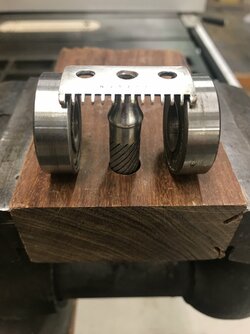Gillette that is.
I just picked this razor up yesterday. I have had a few "old types" but have never made peace with them and this one is no different.
After trying a shave (which lasted about 5 seconds) I took a closer look at it with a magnifier and a straight edge today.
Several teeth are bent. One corner tooth is bent up which keeps the cap from seating properly. Do down facing teeth cause an issue?


The caps corners are all bent down a little like the damage you might find if it was dropped. All four corners? How does that happen. Were they made this way or should that be repaired?
Also the base plate seems to have a slight crown on it from one end to the other along its length. Is that normal?
I am not a collector of "wall hangers". If it doesn't work it gets shipped.
I like the razor and the fact that is it quite a desirable razor. I'm debating if I should sell it as is or try to do a little tune up and see if I can get it to shave better. Bending teeth and maybe doing a little light filing may destroy some of the resale.
Do people tune these up? How?
Thanks in advance
Dirty
I just picked this razor up yesterday. I have had a few "old types" but have never made peace with them and this one is no different.
After trying a shave (which lasted about 5 seconds) I took a closer look at it with a magnifier and a straight edge today.
Several teeth are bent. One corner tooth is bent up which keeps the cap from seating properly. Do down facing teeth cause an issue?
The caps corners are all bent down a little like the damage you might find if it was dropped. All four corners? How does that happen. Were they made this way or should that be repaired?
Also the base plate seems to have a slight crown on it from one end to the other along its length. Is that normal?
I am not a collector of "wall hangers". If it doesn't work it gets shipped.
I like the razor and the fact that is it quite a desirable razor. I'm debating if I should sell it as is or try to do a little tune up and see if I can get it to shave better. Bending teeth and maybe doing a little light filing may destroy some of the resale.
Do people tune these up? How?
Thanks in advance
Dirty
Last edited:


